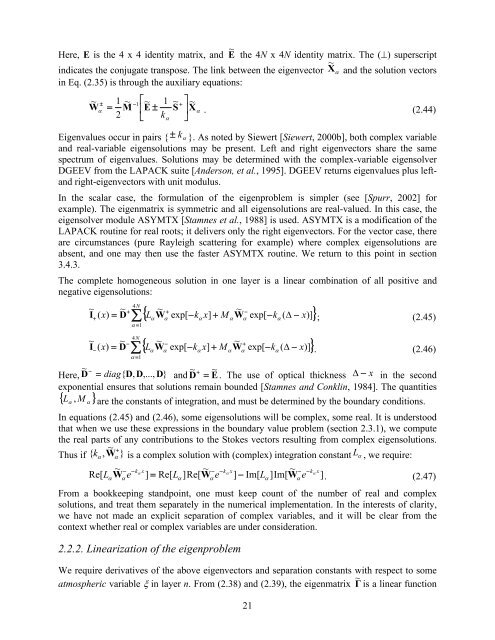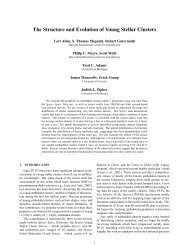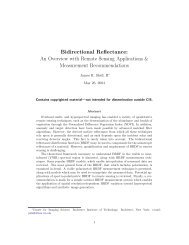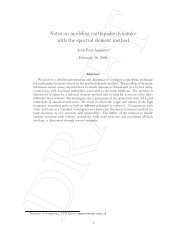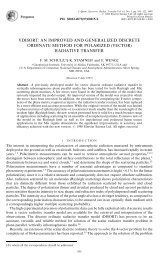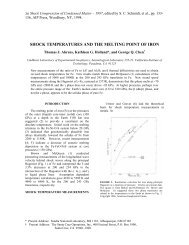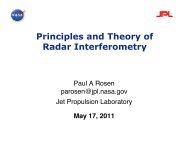In the following sections, we suppress the Fourier index m unless noted explicitly, andwavelength dependence is implicit throughout. We sometimes suppress the layer index n in theinterests of clarity. For matrix notation, ordinary 4 x 1 vectors and 4 x 4 matrices are written inbold typeface, while 4N x 1 vectors and 4N x 4N matrices are written in bold typeface with atilde symbol (N is the number of discrete ordinate directions in the half-space).2.2. Discrete Ordinate Solutions and Linearizations2.2.1. Homogeneous RTE, Eigenproblem reductionFirst, we solve Eq. (2.22) without the solar source term. For each Fourier term m, the multiplescatter integral over the upper and lower polar direction half-spaces is approximated by a doubleGaussian quadrature scheme [Thomas and Stamnes, 1999], with stream directions {±μ i } andGauss-Legendre weights {w i } for i = 1,…N. The resulting vector RTE for Fourier component mis then:±LMNdIi( x)± ωnm+ m− m± μi± Ii( x)= ∑Pl( ± μi)Bl∑wj{ Ij( x)Pl( μj) + Ij( x)Pl( −μj)}dx2. (2.34)l = mj = 1±Eq. (2.34) is a set of 8N coupled first-order linear differential equations for Ii(x). As with thescalar case, these are solved by eigenvalue methods. We follow [Siewert, 2000b] for the mostpart. Solutions for these homogeneous equations are found with the ansatz:±Iα( x,± μi) = Wα( ± μi) exp[ −kαx]. (2.35)We define the (4N x 1) vector (superscript “T” denotes matrix transpose):~ ± TTTW [ ] Tα= Wα( ± μ1),Wα( ± μ2),...., Wα( ± μ N) . (2.36)~ ~ −Equations (2.34) are decoupled using = + ~ ~ ~ −XαWα+ Wαand = + ~YαWα− Wα(sum and differencevectors), and the order of the system can then be reduced from 8N to 4N. This gives aneigenproblem for the collection of separation constants {k α } and associated solution 4N-vectors{ X ~ α }, where α = 1,…4N. The eigenmatrix Γ ~ is constructed from optical property inputs ω andΒ l and products of the matrices Pml( μj) . The eigenproblem is:~ ⊥ ~ 2 ~ ⊥ ~ ~ 2 ~XαΓ = kαXα; ΓX α= kαXα; (2.37)~ ~ + ~ −Γ = S S ; (2.38)LM~ ± ⎡~ω ~± ~ T ~ ⎤ ~ −1S = ⎢E− ∑ Π(l,m)BlA Π ( l,m)Ω2⎥Μ; (2.39)⎣ l=m⎦mmm[ P ( μ ), P ( μ ),...., P ( μ ] T~Π ( l,m)= diag; (2.40)l1 l 2 l N)~M = diag[ μ1E,μ2E,...,μNE]; (2.41)~Ω = diag [ w1E,w2E,...,wNE]; (2.42)A±l−m= E ± ( −1)D . (2.43)20
Here, E is the 4 x 4 identity matrix, and E ~ the 4N x 4N identity matrix. The (⊥) superscriptindicates the conjugate transpose. The link between the eigenvector X ~α and the solution vectorsin Eq. (2.35) is through the auxiliary equations:~ ± ~ −1α = MW12⎡~1⎢E±⎣ kα~S+⎤ ~⎥X⎦α. (2.44)Eigenvalues occur in pairs { ± kα}. As noted by Siewert [Siewert, 2000b], both complex variableand real-variable eigensolutions may be present. Left and right eigenvectors share the samespectrum of eigenvalues. Solutions may be determined with the complex-variable eigensolverDGEEV from the LAPACK suite [Anderson, et al., 1995]. DGEEV returns eigenvalues plus leftandright-eigenvectors with unit modulus.In the scalar case, the formulation of the eigenproblem is simpler (see [Spurr, 2002] forexample). The eigenmatrix is symmetric and all eigensolutions are real-valued. In this case, theeigensolver module ASYMTX [Stamnes et al., 1988] is used. ASYMTX is a modification of theLAPACK routine for real roots; it delivers only the right eigenvectors. For the vector case, thereare circumstances (pure Rayleigh scattering for example) where complex eigensolutions areabsent, and one may then use the faster ASYMTX routine. We return to this point in section3.4.3.The complete homogeneous solution in one layer is a linear combination of all positive andnegative eigensolutions:~ ~I ; (2.45)~4N~ +~ −∑{ LαWαexp[ −kαx]+ MαWαexp[ −kα( Δ x)]}++( x)= D−α = 1~4N~ −~ +∑{ LαWαexp[ −kαx]+ MαWαexp[ −kα( Δ − x)]}−I−( x)= D. (2.46)α = 1~ −~ + ~Here, D = diag{D,D,...,D}and D = E. The use of optical thickness Δ − x in the secondexponential ensures that solutions remain bounded [Stamnes and Conklin, 1984]. The quantities{ Lα, M α} are the constants of integration, and must be determined by the boundary conditions.In equations (2.45) and (2.46), some eigensolutions will be complex, some real. It is understoodthat when we use these expressions in the boundary value problem (section 2.3.1), we computethe real parts of any contributions to the Stokes vectors resulting from complex eigensolutions.~Thus if { k +α, W α} is a complex solution with (complex) integration constant Lα , we require:~ − −k~~α x− −kαx− −kαxRe[ LαWαe ] = Re[ Lα]Re[ Wαe ] − Im[ Lα]Im[ Wαe ]. (2.47)From a bookkeeping standpoint, one must keep count of the number of real and complexsolutions, and treat them separately in the numerical implementation. In the interests of clarity,we have not made an explicit separation of complex variables, and it will be clear from thecontext whether real or complex variables are under consideration.2.2.2. Linearization of the eigenproblemWe require derivatives of the above eigenvectors and separation constants with respect to someatmospheric variable ξ in layer n. From (2.38) and (2.39), the eigenmatrix Γ ~ is a linear function21
- Page 1: User’s GuideVLIDORTVersion 2.6Rob
- Page 5 and 6: Table of Contents1H1. Introduction
- Page 7 and 8: 1. Introduction to VLIDORT1.1. Hist
- Page 9 and 10: Table 1.1 Major features of LIDORT
- Page 11 and 12: In 2006, R. Spurr was invited to co
- Page 13: corrections, and sphericity correct
- Page 16 and 17: Matrix Π relates scattering and in
- Page 18 and 19: m⎛ P⎞l( μ)0 0 0⎜⎟mmm ⎜ 0
- Page 22 and 23: of the single scatter albedo ω and
- Page 24 and 25: Here T n−1 is the solar beam tran
- Page 26 and 27: ~ + ~ ~ (1)~ ~ + ~ ~ (2)~ ~ − ~ 1
- Page 28 and 29: The solution proceeds first by the
- Page 30 and 31: Linearizations. Derivatives of all
- Page 32 and 33: For the plane-parallel case, we hav
- Page 34 and 35: One of the features of the above ou
- Page 36 and 37: L↑↑ ↑k (cot n −cotn −1)[
- Page 38 and 39: Note the use of the profile-column
- Page 40 and 41: βl,aer(1)(2)fz1e1βl+ ( 1−f ) z2
- Page 42 and 43: For BRDF input, it is necessary for
- Page 44 and 45: streams were used in the half space
- Page 46 and 47: anded tri-diagonal matrix A contain
- Page 48 and 49: in place to aid with the LU-decompo
- Page 50 and 51: In earlier versions of LIDORT and V
- Page 53 and 54: 4. The VLIDORT 2.6 package4.1. Over
- Page 55 and 56: (discrete ordinates), so that dimen
- Page 57 and 58: Table 4.2 Summary of VLIDORT I/O Ty
- Page 59 and 60: Table 4.3. Module files in VLIDORT
- Page 61 and 62: Finally, modules vlidort_ls_correct
- Page 63 and 64: end program main_VLIDORT4.3.2. Conf
- Page 65 and 66: $(VLID_DEF_PATH)/vlidort_sup_brdf_d
- Page 67 and 68: Finally, the command to build the d
- Page 69 and 70: Here, “s” indicates you want to
- Page 71 and 72:
The main difference between “vlid
- Page 73 and 74:
to both VLIDORT and the given VSLEA
- Page 75 and 76:
STATUS_INPUTREAD is equal to 4 (VLI
- Page 77 and 78:
5. ReferencesAnderson, E., Z. Bai,
- Page 79 and 80:
Mishchenko, M.I., and L.D. Travis,
- Page 81:
Stamnes K., S-C. Tsay, W. Wiscombe,
- Page 84 and 85:
Table A2: Type Structure VLIDORT_Fi
- Page 86 and 87:
DO_WRITE_FOURIER Logical (I) Flag f
- Page 88 and 89:
USER_LEVELS (o) Real*8 (IO) Array o
- Page 90 and 91:
angle s, Stokes parameter S, and di
- Page 92 and 93:
DO_SLEAVE_WFS Logical (IO) Flag for
- Page 94 and 95:
6.1.1.8. VLIDORT linearized outputs
- Page 96 and 97:
NFINELAYERS Integer Number of fine
- Page 98 and 99:
6.1.2.4. VLIDORT linearized modifie
- Page 100 and 101:
The output file contains (for all 3
- Page 102 and 103:
The first call is the baseline calc
- Page 104 and 105:
for a 2-parameter Gamma-function si
- Page 106 and 107:
Remark. In VLIDORT, the BRDF is a 4
- Page 108 and 109:
6.3.3.1. Input and output type stru
- Page 110 and 111:
Table C: Type Structure VBRDF_LinSu
- Page 112 and 113:
Special note regarding Cox-Munk typ
- Page 114 and 115:
squared parameter, so that Jacobian
- Page 116 and 117:
6.4. SLEAVE SupplementHere, the sur
- Page 118 and 119:
is possible to define Jacobians wit
- Page 120 and 121:
etween 0 and 90 degrees.N_USER_OBSG
- Page 122:
6.4.4.2 SLEAVE configuration file c


